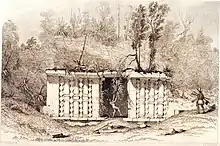Kiuic is a Maya archaeological site in the Puuc region of Yucatán, Mexico.

So called "Diamantes" building in the early 1840s
History
Kiuic (/kjuˈiːk/ kyoo-EEK[1]) was a Maya city of the Late and Terminal Maya Classic Periods, with evidence of earlier occupation. It was abandoned by the Maya around 880 CE.[2] The site is well-preserved, and in that regard compared by archaeologists to Pompeii.[2]
Archaeology
First documented in print by John Lloyd Stephens and Frederick Catherwood in 1843, the site was visited by later Mayanists including Teoberto Maler.
The site has been under-going archaeological exploration since 2000, in part by Millsaps College archaeologists.[3] Kiuic was extensively discussed in a PBS Nova and National Geographic special.[4] [5]
References
- ↑ "Kaxil Kiuic - Full Video". Retrieved 15 April 2020.
- 1 2 Vergano, Dan (August 25, 2010). "Archaeologists find new clues why the Maya left". USA Today. USA Today. Retrieved September 10, 2014.
- ↑ "Millsaps field work". Millsaps College. Millsaps College. Archived from the original on December 30, 2013. Retrieved September 10, 2014.
- ↑ "Quest for the Lost Maya". PBS. PBS. Retrieved September 10, 2014.
- ↑ "Lost World of the Maya". NationalGeographic. NationalGeographic. Retrieved February 18, 2021.
External links
Wikimedia Commons has media related to Kiuik.
This article is issued from Wikipedia. The text is licensed under Creative Commons - Attribution - Sharealike. Additional terms may apply for the media files.